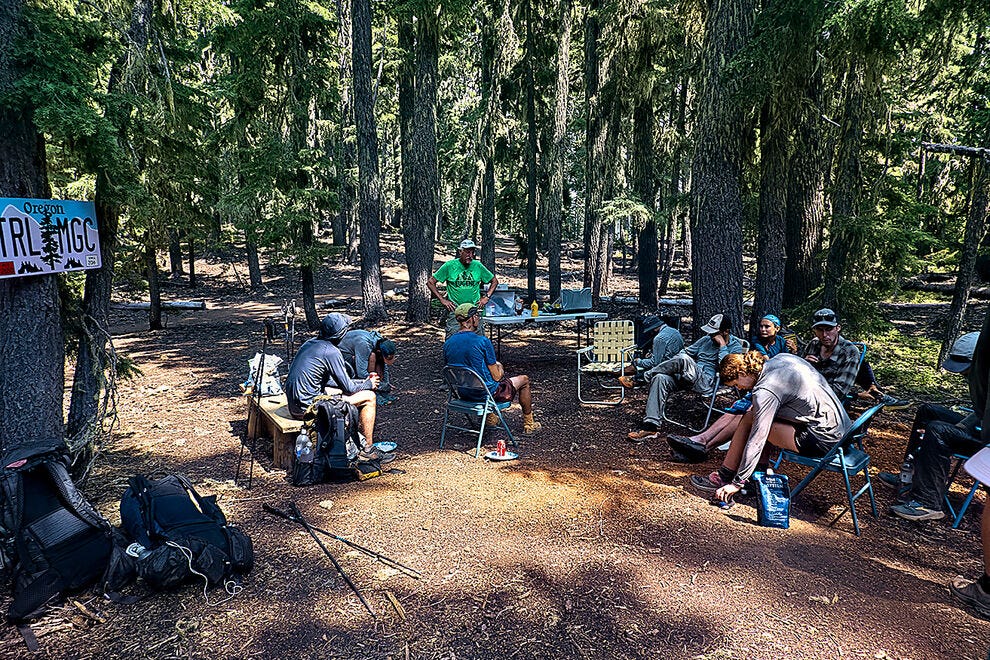 PCT marker in Oregon — Photo courtesy of Dave Stamboulis
PCT marker in Oregon — Photo courtesy of Dave Stamboulis
At 2,654 miles, the Pacific Crest Trail, or PCT as it’s more commonly known in the hiking community, is considered the longest designated hiking trail in the world. Stretching from Campo, CA, near the Mexican border, to its northern terminus at Manning Park on the Washington-Canada border, it is a favorite destination for enthusiasts of long distance “thru-hiking.”
Each year, thousands of hikers set out on this “bucket list” trek of a lifetime. The trail played a starring role in the famous memoir, “Wild: From Lost to Found on the Pacific Crest Trail,” by Cheryl Strayed, which was also made into an award-winning 2014 film. Along the PCT, outdoor enthusiasts face challenges of the California desert and High Sierras, along with the Cascade mountains of Oregon and Washington. Timing is crucial on this trail, and trips are planned carefully so hikers reach the finish line before the winter snow.
While you need to be an avid hiker to pull off a long distance journey of this magnitude, you don’t necessarily need to do it all in one go. Plenty of people hike sections, knocking off one state or one region at a time (the desert or the Sierras, for example). For casual hikers, perhaps a weekend on the trail is a great option for enjoying nature. Whichever way you go, the PCT will certainly reward you — mentally, physically and spiritually.
Here are the 10 best reasons to hike the Pacific Crest Trail right now.
Surround yourself with springtime desert wildflowers
 Wildflowers in the Mojave on the PCT — Photo courtesy of Dave Stamboulis
Wildflowers in the Mojave on the PCT — Photo courtesy of Dave Stamboulis
The desert portion of the PCT stretches several hundred miles from the southern terminus at the Mexican border up into the Sierra foothills. It can be hot and dry, but hiking here in the springtime also gives trekkers a chance to witness the amazing colors that appear in the Anza-Borrego and Mojave sections. Desert marigolds, lilies, bluebells and splashes of golden poppies are just some of the fantastic technicolor displays seen along the way.
Witness a Mount Whitney sunrise
 Sunrise on Mt. Whitney — Photo courtesy of Dave Stamboulis
Sunrise on Mt. Whitney — Photo courtesy of Dave Stamboulis
At 14,505 feet, Mt. Whitney is the highest peak in the contiguous United States. Located just off the PCT, it’s a long and tough climb, but most PCT hikers are already acclimated to the elevation by the time they arrive. Reaching the summit for an unforgettable sunrise is one most memorable experiences of any PCT journey. (Be sure to check the latest wilderness permit requirements.)
Join a welcoming trail community
 Hikers at Mom’s Pie in Julian, CA — Photo courtesy of Dave Stamboulis
Hikers at Mom’s Pie in Julian, CA — Photo courtesy of Dave Stamboulis
Hikers relish the friendly small towns that serve as rest points along the way. These towns are familiar with hikers’ needs for vitals like food, gear and showers. In places like Julian, Quincy or Sierra City in California, trekkers are welcomed with all sorts of kindnesses. One special landmark is Mom’s Pie House in Julian. Here, all thru-hikers are warmly greeted with free pie, ice cream and coffee.
Trek the High Sierras and through national parks
 Heading to Glen Pass in the Sierras — Photo courtesy of Dave Stamboulis
Heading to Glen Pass in the Sierras — Photo courtesy of Dave Stamboulis
California’s Sierra Nevada range is one of the PCT’s top highlights and an unforgettable experience. Featuring dramatic scenery every step of the way, the Sierra section of the trail runs just shy of 400 miles and meanders through remote wilderness. Considered the most challenging part of the trail, it also passes through both Yosemite and Sequoia and Kings Canyon National Parks. This part of the trail is memorable, and home to abundant wildlife, soaring peaks and high-altitude, snowy passes.
Challenge yourself physically and mentally
 Hikers crossing Evolution Creek in Kings Canyon National Park — Photo courtesy of Dave Stamboulis
Hikers crossing Evolution Creek in Kings Canyon National Park — Photo courtesy of Dave Stamboulis
Carrying a pack with everything you need, along with walking through heat, cold and extremes of terrain, are just some of the obstacles facing Pacific Crest Trail hikers. You’ll also need to be disciplined enough to put in the required miles each day, navigate through snow and get along nicely with your tent-mate. Whether you’re fording a river in the Sierras or putting tape on your blistered feet, you’ll rise to many challenges on this journey.
Hike Goat Rocks Wilderness in Washington
 Traversing the Goat Rocks — Photo courtesy of Dave Stamboulis
Traversing the Goat Rocks — Photo courtesy of Dave Stamboulis
Goat Rocks Wilderness in the state of Washington is a section of the Cascade mountain range and a favorite portion of the trail for many hikers. It’s incredibly scenic and features some of the most dramatic views of iconic Mount Rainier. If headed south, the panorama is just as staggering, because Mount Adams, another beautiful Cascade volcano, is in front of you all the way. The Cascade high country is often only accessible to alpine rock climbers, but this section can be tackled by anyone who’s up for it.
Enjoy camaraderie and make new friends along the trail
 Colorful characters are a PCT norm — Photo courtesy of Raquel Mogado
Colorful characters are a PCT norm — Photo courtesy of Raquel Mogado
Perhaps even more important than the scenery, a PCT trek is all about the wonderful friends you make along the way. Hikers often form groups known as “tramilies” (trail families) when they find others with the same pace or mindset. You’ll meet an incredible variety of characters, whether it be entire families hiking with their children, people traveling with dogs or cats, those wearing Scottish kilts — or some even hiking in bathrobes! The PCT is truly a place to be yourself with no constraints.
See the stunning North Cascades
 Beautiful Glacier Peak Wilderness, North Cascades — Photo courtesy of Dave Stamboulis
Beautiful Glacier Peak Wilderness, North Cascades — Photo courtesy of Dave Stamboulis
Heading north, the PCT finishes with a bang, as it travels across the North Cascades National Park, an area of jagged peaks and hundreds of glaciers. If you get here in the early fall, there are wild blueberries and huckleberries to pick right on trail. The rain and snowfall this far north always ensures a lush green landscape as you head toward the finish line.
Get saved by the famous “Trail Angels” along the way
 Hikers being treated to hot dog “trail magic” — Photo courtesy of Dave Stamboulis
Hikers being treated to hot dog “trail magic” — Photo courtesy of Dave Stamboulis
Most hikers wouldn’t make it alone through the PCT without some help. Along the way, hikers need water in the desert, rides from the trail to town and assistance in getting around fire closures (or other obstacles). Fortunately, there’s a dedicated community of “trail angels” to assist in all sorts of ways. These saviors arrive at trailheads with an abundance of supplies, including snacks and cold drinks. They often offer laundry services, shower facilities and help with emergency gear replacement. Trail angels have become an essential part of the PCT experience — their “trail magic” is a memorable hike highlight.
Immerse yourself in the remote wilderness
 Grand solitude in the High Sierras — Photo courtesy of Dave Stamboulis
Grand solitude in the High Sierras — Photo courtesy of Dave Stamboulis
If you do a thru-hike, or even a section of the PCT, chances are you’ll always remember this time in your life when you lived in the wilderness. The freedom of where to stop, the skills learned traveling in snow, and the lessons taken from spending weeks or months away from cars and noise will remain forever. All these, along with the mix of solitude and the sublime, make the PCT a true odyssey of a lifetime.


